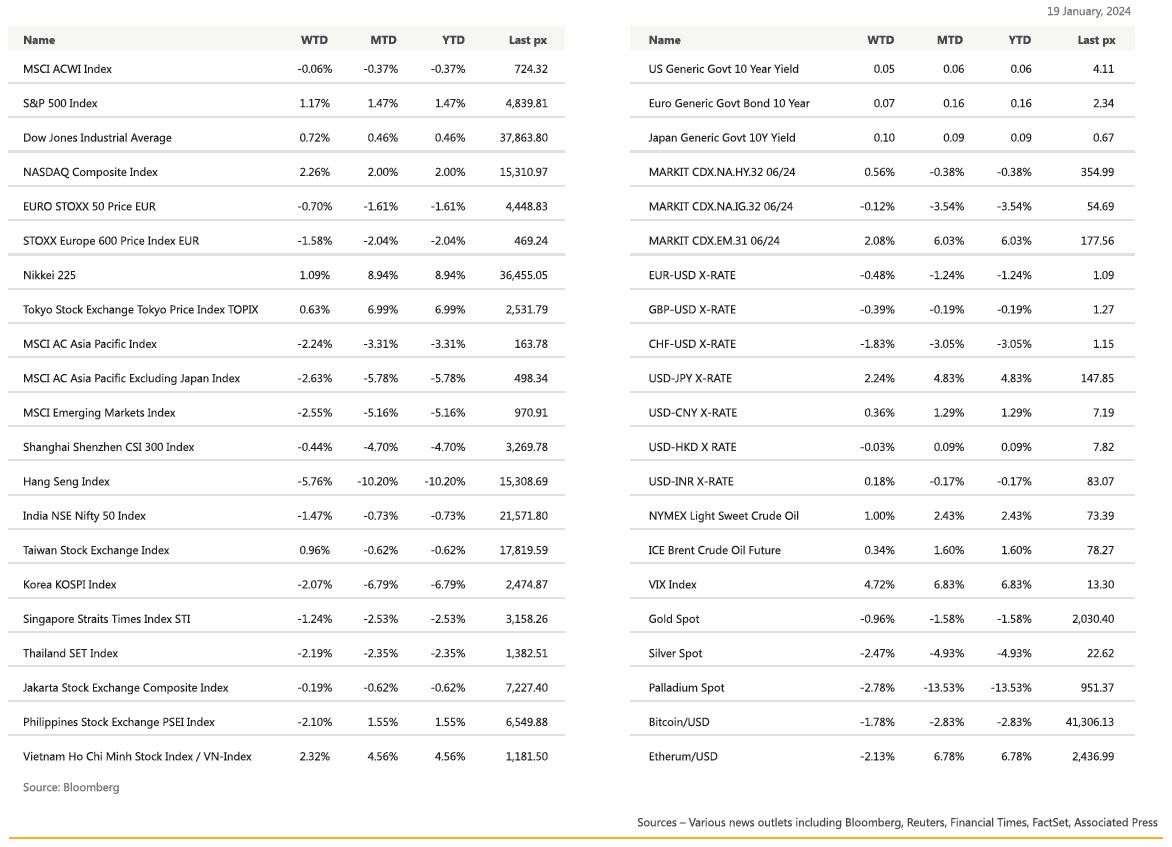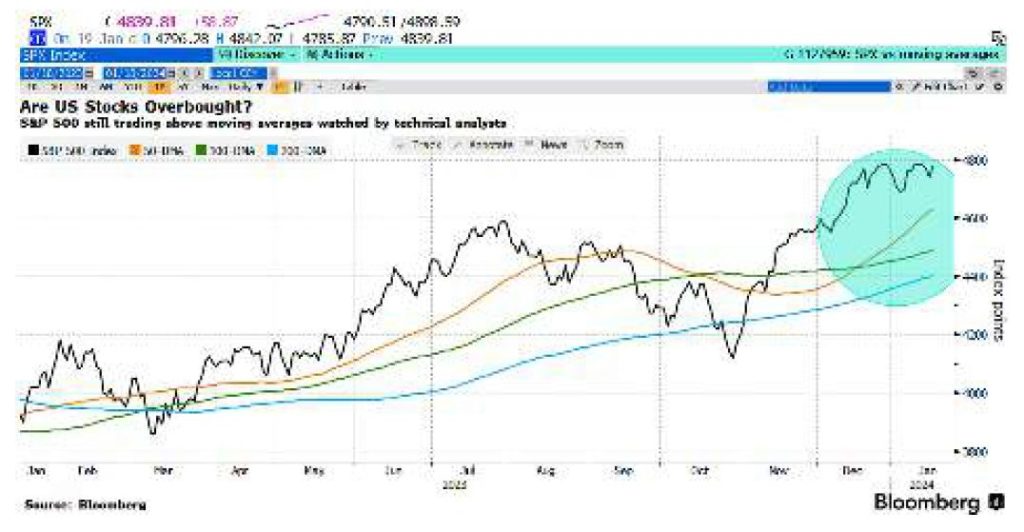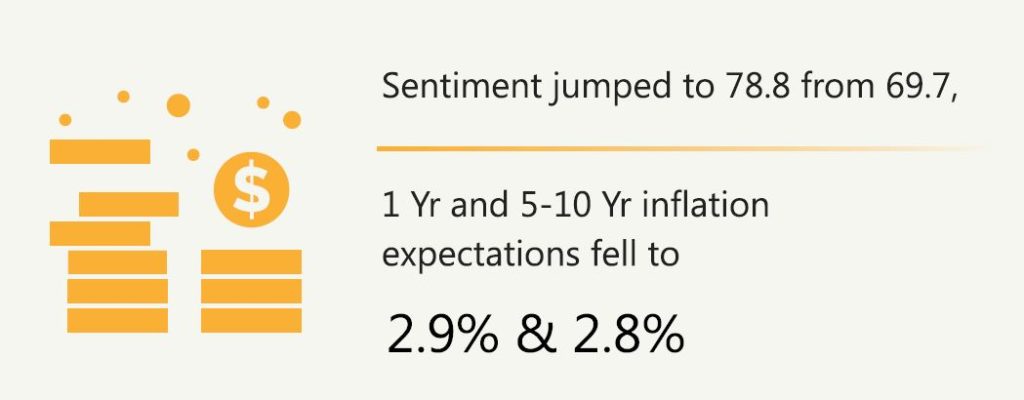KEY MARKET MOVES
MACRO OVERVIEW

US
Semiconductor stocks were the stars for the week, leading the Nasdaq with its largest gain for the week pulling both the S&P 500 and Dow with it. A bullish earnings report on Thursday from Taiwan’s TSMC was the main trigger which then sent Nvidia, Apple and Microsoft higher, becoming the biggest contributors to the S&P’s gains on Friday .
Helping with sentiment was also news that Congress passed a continuing resolution to fund the government, at least until March, which prevented a government shutdown. The S&P 500 Index finally finished at an all-time high for the first time in two years on Friday, marking a crucial milestone in the resurgence of the US stock market. Markets started the shortened week on its back foot initially following Fed-speak that pushed back the consensus’ view of a March rate cut. Federal Reserve Governor Christopher Waller said the US central bank should take a cautious and systematic approach when it begins cutting interest rates. His comments pushed yields higher, with the UST10’s and 2’s at 4.12% and 4.38% respectively. Atlanta’s Bostic said he was open to earlier cuts on faster drop in inflation but would be comfortable to do so only in Q3. Technical traders are starting to question if.…..US stocks are overbought?

Regardless, BoA reported that global investors are the most overweight in US equities since 2021. Consensus reports that earnings for Tech Stock is still rising as analyst forecasts drive the sector higher, with focus on generative AI remaining firm.
Even MS’ Wilson (last year’s big bear) noted earnings estimates have been slashed so much over the past three months that Wall Street strategists now expect most companies will easily beat analyst forecasts this season. Thus far, the majority of companies that have reported are surprising positively.
Data wise, the Labor Department report showed that initial jobless claims unexpectedly fell last week, underscoring the economy’s resilience on the heels of the stronger-thanforecast retail sales and industrial production figures Wednesday undermining the prospect of a March rate cut. U. of Mich. Sentiment jumped to 78.8 from 69.7, 1 Yr and 5-10 Yr inflation expectations fell to 2.9% and 2.8% respectively.
This week will see a couple of major releases being GDP and personal consumption on Thursday and PCE deflator on Friday. We are expecting MoM figure to tick up to 0.2% and the YoY to fall to 3%. Cryptos ran into a brick wall of profit taking as the dust settles on recent ETF listings. Ether ETF’s are the next rage now.
Growth stocks appear to remain in vogue with renewed enthusiasm in Semis. We identified a couple here within the Philadelphia Semiconductor Index that remain relatively well priced to consider: Qualcomm and Applied Materials.

Europe
European markets closed slightly lower Friday, with the Stoxx 600 index 0.3% lower. Mining stocks led losses, down 1.4% while technology stocks rose 0.6%. The World Economic Forum in Switzerland ended with the message from monetary policymakers stating that good progress has been made to bring inflation down to 2% but that market pricing for a cut from the ECB as soon as March or April may be still premature.
On data releases, UK retail sales disappointed Friday, coming down by 3.2% in December, significantly more than expected. It was the largest monthly fall since January 2021, when the pandemic restricted sales. The headline CPI rose 0.5% m/m in December, similarly for core prices. Despite the upside surprise to December CPI, it remained 0.6 pp below the BoE’s forecast in the November MPR. Along with pay growth continuing to ease, this should be enough for all MPC members to consider keeping rates unchanged at the February meeting. This week, the PMI and consumer confidence survey will provide the final update on the economy before the February meeting.
Over in the EU, last week’s final HICP report for December confirmed the flash estimates, with a slight uptick to 0.5% from the preliminary 0.4%. Annualized core HICP held steady at 3.4%.
Industrial Production fell 0.3% m/m in November, output across energy-intensive sectors remains stuck at a low level despite the fall in gas prices since September 2022. Furthermore, the rebound in car production stalled last year when car production approached the pre-pandemic level. Euro IP remains on a downward trend and the latest PMI readings do not hint at a very significant improvement late last year.
This week’s ECB meeting will be important, but maybe not as important as the data before and after it. ECB President Lagarde did not rule out the possibility of a rate cut either before or after the summer season but leaned heavily into “data-dependency’’ rhetoric, highlighting the services sector inflation remains near 4%, well above targets, which means the data could change the views of ECB. The focus will be on ECB’s updated views on growth and inflation, and on any forward guidance. Recent comments have pushed back against early rate cut expectations but have left June open for a first cut. By then the ECB will have a much better idea of the trend in inflation and wages, with the 1Q24 wages data coming in late for April. Some of the recent slowing in core inflation may still reflect transitory factors fading out, whilst the stronger wage data may give more stickiness going forward. This mindset will then affect the meeting this week.
Apart from this week’s flash PMI, the flash HICP next week after the meeting will be key.
Asia
Asian markets continued its downtrend last week, MSCI Asia ex Japan was lower by 2.63%. Hang Seng index led the declines, down 5.76% for the week and 10.2% for the month. Hang Seng logged third straight weekly losses, the worst start of a year since 2016. Japan, Taiwan and Vietnam bucked the downtrend, closing higher last week. Japanese shares were lifted by chip-industry stocks after Taiwan Semiconductor Manufacturing projected 2024 revenue growth of over 20%.
China’s gross domestic product grew 5.2% in 2023, slightly beating Beijing’s official target as the world’s second-largest economy grappled with a property sector crisis, falling exports, deflationary pressures, as well as a declining population. The numbers surpassed official growth targets without relying on “massive stimulus,” according to Chinese Premier Li Qiang. Yet, the lack of convincing stimulus from the government is deterring interest in the market. This morning, at their monthly fixing, China kept benchmark lending rates unchanged. The one-year loan prime rate (LPR) was kept at 3.45%, and the five-year LPR was unchanged at 4.20%.
Governor Shaktikanta Das said India’s central bank would not consider bank rate cuts unless inflation settled firmly around the 4% target. Whilst mentioning rate cuts would depend on domestic factors, he reiterated economic growth would likely touch 7% for the fiscal year, with inflation at a 4.5% average.
Sri Lanka’s Colombo port has seen a big jump in container volumes in recent weeks as vessels steering clear of tensions in the southern Red Sea have found it a convenient transit point, officials said on Tuesday. Due to Colombo’s strategic location, stopping at the port gives ships convenient access to the Middle East, South Asia and East Asia, said Lal Weerasinghe, a senior official at the Sri Lanka Ports Authority (SLPA).
Other data points from Asia: China’s population fell for the second consecutive year in 2023, shrinking by 2.08M to 1.410B. Total deaths reached 11.1M, more than an average year as the first Covid wave struck the country in Q1, while total births fell to a record low 9.02M from 9.56M. The overall population decline was at faster pace than in 2022. Japan producer price inflation was flat for the first time since Feb-21, relieving pressure on the BOJ that had been under pressure on rates; bank forecast to cut near-term core inflation forecasts this week. Data from the Japan National Tourism Organization (JNTO) showed the number of foreign visitors for business and leisure rose to 2.73 million last month from 2.44 million in November. Bank Indonesia maintained its policy rate at 6.0%. Expecting CPI to remain benign through 2024.
GeoPolitics
Israel – Palestine: Israeli Prime Minister Benjamin Netanyahu rejected what he said were unacceptable terms presented by Hamas for a new hostage deal. “Hamas is demanding, in exchange for the release of our hostages, the end of the war, the withdrawal of our forces from Gaza,” Netanyahu said in a video statement. He said Hamas was also demanding a release of terrorists who killed some 1,200 people in October and the continued existence of Hamas — which Israel has vowed to destroy.
China: China’s Foreign Minister Wang Yi, last week, called for the establishment of a Palestinian state and a ceasefire in Gaza, where 100 days of the Israel-Hamas war have killed thousands. In a press conference with his Egyptian counterpart Sameh Shoukry in Cairo, the top Chinese diplomat said: “It is necessary to insist on the establishment of an independent, fully sovereign state of Palestine on the 1967 borders, with East Jerusalem as its capital.” This weekend, a Houthi spokesperson said that Russian and Chinese ships are not under threat in the Red Sea, as the rebel groups carries out attacks on Israel-linked ships.
US – Yemen : The US military carried out new strikes in Yemen last week against anti-ship ballistic missiles in a Houthicontrolled part of the country as a missile struck a Greek-owned vessel in the Red Sea. The Houthis say they are acting in solidarity with Palestinians and have threatened to expand its attacks to include US ships in response to American and British strikes on its sites in Yemen. The Biden administration in 2021 had taken the Houthis off two lists designating them as terrorists, reversing a decision by former President Donald Trump. The latest move would put the Houthis back on one of the two lists, marking them as “specially designated global terrorists.”
Iran – Pakistan: Iran says it’s hit militant targets over the border in western Pakistan, in what is Iran’s third airstrike on another country this week (after hitting sites in Iraq and Syria). Pakistani officials decried the strike (which reportedly killed two children) and warned of “serious consequences”. Pakistan conducted strikes inside Iran on Thursday, targeting separatist Baloch militants, the Pakistani foreign ministry said, two days after Tehran said it had attacked the bases of another group within Pakistani territory.
The West – Russia: Western officials said in Davos on Wednesday they were open to the idea of confiscating $300 billion of Russian assets to help Ukraine, but cautioned that the devil was in the legal detail and that, even if it could be done, it would be no panacea for Kyiv. Russia, which was not represented at Davos, has warned that confiscation of those assets would go against the principles of free markets and the Kremlin has warned it would seize U.S., European and other assets in response to such a move.
Credit/Treasuries
On Tuesday Governor Waller’s prepared remarks were not as dovish as the current market pricing on rate cuts implied. He stated that the Fed can lower interest rates ‘methodically and carefully’ this year if inflation continues moderating. “Methodically and carefully” could be considered as quarterly rather than every meeting. He highlighted the distinction between a reactive and proactive cutting cycle. Most past easing cycles have been in response to a negative shock to growth or financial conditions, but Waller suggested that upcoming easing could be more gradual and deliberate.
The market seems content to fight the Fed on the pace and extent of easing in 2024, likely at least in part because of the pattern of past cutting cycles.
Quite a lot of volatility on interest rates last week, supported by mostly strong data in the US as well as some less dovish Fed members comments. The 2years US Treasury yield rebounded by 19bps, 5years gained 12bps, 10years +8bps & 30years 4bps. Credit spreads on both IG & HY were a little bit tighter over the week. In terms of performance, US IG lost 1.30% & US HY lost 0.70% over the week and leverage loans were up by 10bps.
FX
DXY USD Index rose 0.86% to close the week at 103.28, driven by strong US macro data and hawkish remarks from Fed policy makers, who pushed back against not only the timing, but the pace of rate cuts priced by the market. The probability for a March rate cut has now fallen below 50% with a little over five cuts priced in for this year. Data wise, new claims fell to 187k (C: 205k; P: 203k), the lowest level since September 2022. Headline Retail Sales rose by 0.6% m/m in December (C: 0.4%; P: 0.3%) and Control Sales rose by 0.8% m/m in December (C: 0.2%; P: 0.5%), underpinned by firm holiday spending. Resoundingly strong preliminary January University of Michigan Consumer Sentiment at 78.8 (C: 70.1), coupled with a decline in 1y inflation expectations to 2.9% (C: 3.1%) – the lowest since December 2020. Immediate resistance at 103.45 (200 days MA), and 103.70 (YTD High). Immediate support at 103.115 (50 Days MA) and 102.80.
EURUSD fell 0.48% to close the week at 1.09, driven by USD strength. ECB President Lagarde acknowledged it is likely the ECB will cut rates in the summer but stresses the aggressive pricing of rate cuts are not “helping our fight against inflation. EURCHF rose 1.34% to close the week at 0.946, as CHF weakens post comments from SNB President, which fuelled expectations the central bank may increasingly be comfortable with currency weakness. Immediate support on EURUSD at 1.0845 (200 days MA) and 1.077 (100 days MA).
GBPUSD fell 0.39% to close the week at 1.2703, driven by weak UK retail sales and USD strength. UK Retail Sales (including auto fuel) fell by 3.2% m/m in December (C: -0.5%; P: 1.4%), signalling that the UK economy was likely in a technical recession in 2H23. In addition, UK core CPI came in strong at 5.1% y/y in December (C: 4.9%). Resistance level at 1.28, while support level at 1.26 and 1.255 (200 days MA).
USDJPY rose 2.24% to close the week at 148.12, driven by higher UST yields (2 yrs rising 24 bps). We have the BoJ rate decision this Tuesday, where BoJ is expected to hold rate. Data wise, JP Nationwide CPI for December reported Japan-style Core CPI (ex-fresh food) eased to 2.3% y/y (C: 2.3%; P: 2.5%), which mainly reflected a decline in the contribution from energyrelated items.
Oil & Commodities
Crude Oil rose last week, with WTI and Brent rising 1.00% and 0.34% to close the week at 73.41 and 78.56 respectively, as geopolitical tensions in the Middle East remains high.
Gold fell 0.96% to close the week at 2029.5, driven by USD strength amidst higher UST yields. Support level at 2020/2000, while resistance level at 2040/2065.
Economic News This Week
-
Monday – CH LPR, US Leading Index
-
Tuesday – AU Biz Confid., JP BoJ Rate Decision, EU Cons. Confid., US Richmond Fed Mfg Index
-
Wednesday – NZ CPI, JP Trade Balance, AU/JP/EU/UK/US Mfg/ Svc/Comps PMI Jan Prelim., US MBA Mortg. App., CA BoC Rate Decision
-
Thursday – JP Machine Tool Orders, NO Norges Bank Rate Decision, EU ECB Rate Decision, US GDP/Personal Cons./ Core PCE/ Durable Goods Orders/ Initial Jobless Claims/ New Home Sales
-
Friday – JP Tokyo CPI, UK Cons. Confid., SW Unemploy. Rate, US Personal Income/ Personal Spending/ Pending Home Sales
Sources – Various news outlets including Bloomberg, Reuters, Financial Times, FactSet, Associated Press
Disclaimer: The law allows us to give general advice or recommendations on the buying or selling of any investment product by various means (including the publication and dissemination to you, to other persons or to members of the public, of research papers and analytical reports). We do this strictly on the understanding that:
(i) All such advice or recommendations are for general information purposes only. Views and opinions contained herein are those of Bordier & Cie. Its contents may not be reproduced or redistributed. The user will be held fully liable for any unauthorised reproduction or circulation of any document herein, which may give rise to legal proceedings.
(ii) We have not taken into account your specific investment objectives, financial situation or particular needs when formulating such advice or recommendations; and
(iii) You would seek your own advice from a financial adviser regarding the specific suitability of such advice or recommendations, before you make a commitment to purchase or invest in any investment product. All information contained herein does not constitute any investment recommendation or legal or tax advice and is provided for information purposes only.
In line with the above, whenever we provide you with resources or materials or give you access to our resources or materials, then unless we say so explicitly, you must note that we are doing this for the sole purpose of enabling you to make your own investment decisions and for which you have the sole responsibility.
© 2020 Bordier Group and/or its affiliates.